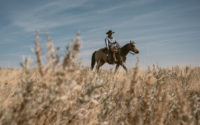An Unexpected Eagles Cover
Growing up, the anodyne American rock of the Eagles regularly soundtracked my weekends. Not by choice. Like many children up until a certain age, I was beholden to my parents’ musical taste, which trended toward the easier listening of what would later become known as “yacht rock.” There was a lot of Steely Dan and The Doobie Brothers. The Eagles were a big part of that, too, though the architects responsible for constructing the ensuing yacht rock genre felt the band’s sound didn’t quite fit. I couldn’t tell the difference as a kid. It all sounded of a piece: chill rock for wistful adults reveling in that potent twentieth-century myth known as “the glory days.”
How surprising, then, that a cover of “Take It to the Limit,” one of the Eagles’ most well-known singles (from their 1975 album One of These Nights), would come to capture so much of my recent attention. The duet from Canadian singer-songwriter Leif Vollebekk and Australian singer-songwriter Angie McMahon follows their last gorgeous collaboration “If You Call,” and makes stirring use of their heady harmonies. I haven’t been able to stop playing it.
Vollebekk has long been one of my favorite musicians going thanks to his jazzy perspective and smoky tendril of a voice. He also happens to write a poetic turn of phrase, as on the meditative “Photographer Friend“: “A picture’s worth a thousand words, it explains why we don’t talk / As we travel past the perfumed rows of hemlock trees.” Beyond his originals, Vollebekk’s ear for production has led to some enthralling covers, like a piano-forward rendition of Kendrick Lamar’s “LOVE.”
Vollebekk’s “Take It to the Limit” prods a greater reverie out of the reflective song. The original’s sedate rhythm and saccharine production—that classic choice of backing vocals and strings to enlarge the sentiment— juxtapose the song’s central idea of refusing to relinquish any enthusiastic grasp on life despite its many disappointing turns. How curious to turn this drive to keep “punching away at [life],” as writer Randy Meisner discussed in a 1977 interview, into a sauntering ballad.
In Vollebekk’s hands, gone are the drums. Instead, an acoustic guitar and upright bass keep a slower tempo while pedal steel sends up smoke signals in and around that framing, as if hoping to receive back a solid piece of shining wisdom. You can hear a touch of hope in the Eagles’ version, but Vollebekk’s narrator sings as though the hits he’s taken have scraped away the verve needed to get back up and keep moving. He’s looking for proof of some sort. “But the dreams I’ve seen lately/ Keep on turning out and burning out/ And turning out the same,” he sings plaintively. It’s a woozy, dreamlike take flickering with remorse.
Stripped down in this manner, “Take It to the Limit” sounds closer to the song’s true meaning, and perhaps that’s why I find myself so drawn to this particular cover. There’s an honesty humming about the edges. Who doesn’t feel some sort of depleted awe at where they’ve ended up in life?
I suppose I shouldn’t be too surprised that, at long last and thanks to a sort of sideways routing, the Eagles have made it back into my life. After all, Steely Dan’s “Hey Nineteen” has become a song I cherish, and I now own most of their catalog on vinyl and some of the Doobies as well. I don’t know that I’ll ever find my way properly into the Eagles, but I am altogether delighted to spend some time with them if Vollebekk is the one translating.




